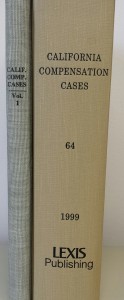UPDATE: The WCAB has decided to proceed as described above. Navarro is now an en banc opinion.
Alright dear readers, you’ve made it – it’s Wednesday, and the ripples of last week’s en banc decisions are starting to fade. Before too long, it will be Friday again, and it will be business as usual in the world of workers’ compensation.
The second decision of the two released last week by the WCAB, which seems to have received considerably less attention than the Dubon case, is that of Ismael Navarro v. City of Montebello. Before I go into the details of that case, I’d like to relate to you what I overheard being put before a WCJ at one of the Boards in the Bay Area.
The parties had agreed to use a particular AME for applicant’s back injuries (a CT and a specific). After a re-evaluation, the AME opined that applicant had actually sustained a third back injury, at which point the applicant’s attorney requested a panel as to that injury.
The defense attorney promptly filed a DOR, and the parties appeared before the Judge to argue the issue of whether applicant’s agreement to use an AME binds him to that AME for all future questions of injury (particularly if it is the same body part at issue). Applicant argued that the arrangement to submit all issues to an AME was one of contract, and there was no agreement to an evaluator for future injuries. The Defense attorney argued that this was the same body part and still the same employer, therefore the original agreement applied to this new, alleged injury.
The Judge offered some guidance towards mediating the dispute, as good judges often do, but neither attorney nor the Judge could think of any authority that controlled on the issue. Now they do.
In the Navarro matter, applicant had three injuries, allegedly sustained while employed by the same defendant, and all three were to the same body parts. Pursuant to Rule 35.5(e), the defendant argued, the same qualified medical evaluator should have been used for all three injuries.
Upon review, the soon-to-be en banc decision held that 35.5(e) was inconsistent with the labor code and is ruled invalid, allowing an injured worker to seek a new panel for each subsequent injury.
In short, every additional injury claimed can warrant a new panel, so, potentially, you could have three QMEs all opining on different back injuries. You would also have the added bonus of triple the costs of a QME, with potentially as many depositions and record reviews.
I hate to say this – but bad, bad, bad, result!
Turning back to the matter discussed above, it’s true that this case is not binding with respect to AME agreements. However, it strikes at the very heart of the idea that one evaluator’s opinions will be binding for all future injuries. It gives the party that didn’t get to pick a specialty last time a second bite at the specialty apple, and, best of all, it will flood the WCAB with the litigation that workers’ compensation Judges love more than any other: specialty disputes!
So, while this gets sorted out on Appeal, or (hopefully) emergency legislation comes through to amend the Labor Code (don’t hold your breath), what can you do to avoid such messes? Well, not much.
It is questionable whether any agreement for injuries yet to occur could be enforced against the applicant, and so any efforts to agree to use the same evaluator for the future would probably be worth less than the paper this blog is printed upon.
Now, fortunately, this is only a notice of intention to issue an en banc opinion, and the parties and the DWC are invited to submit arguments why there should be a different (or the same) holding. Generally speaking, statutes are not supposed to be interpreted in such a way that would produce an absurd result, but that’s what we would have here:
Injury 1 is evaluated by QME A; who finds that applicant has 8% WPI for his back injury;
Injury 2 is evaluated by QME B; who finds that applicant has 4% WPI for his back injury, and 10% of it can be apportioned to Injury 1;
Injury 3 is evaluated by QME C; who finds that the impairment is total, but not caused by any industrial injury.
Best of all, each QME has a different set of work restrictions. Now, when applicant has not yet resolved his first injury but has already claimed a second, which work restrictions does the employer follow? How does apportionment work when the three QMEs are all giving different opinions on every issue? As the joke goes, when you put three QMEs together for one night, you end up with 5 opinions…
And, best of all, when will the WCJs get to do any substantive work when nine out of every ten hearings is about which panel and which specialty controls for each injury.
Unfortunately, interpreting the Labor Code to invalidated Rule 35(e) will produce an incredibly damaging and harmful result, if not an absurd one. But perhaps the Legislature will have to act to clean this mess up.
To all my beloved readers that have Sacramento on speed dial, I urge you to consider pulling your puppet strings to fix this with an statutory amendment as soon as possible.


